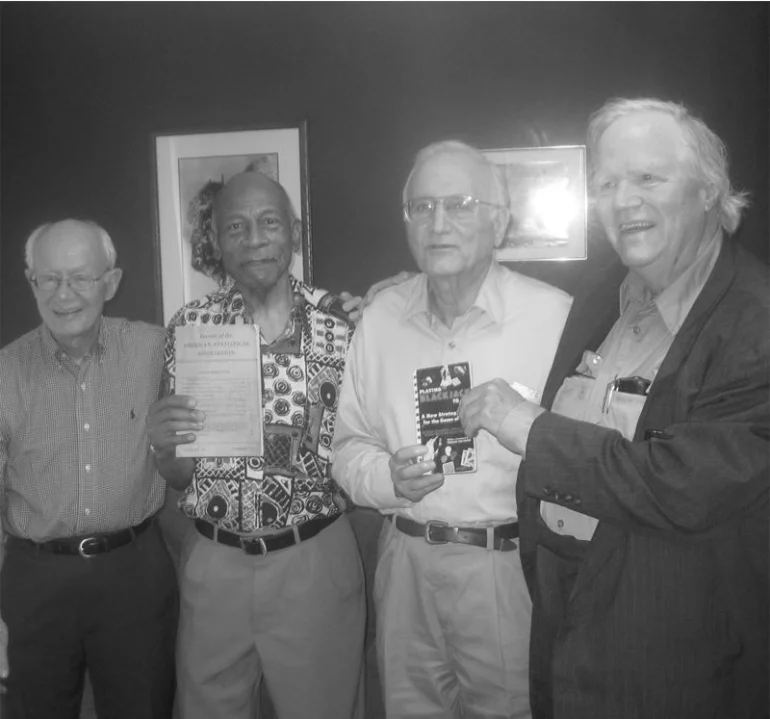
The history of blackjack is rich with tales of strategic minds and groundbreaking approaches. Among the most revered figures are a quartet known as the Four Horsemen of Aberdeen. These pioneering blackjack players significantly impacted the game's evolution, particularly in the realm of basic strategy, and their contributions earned them a well-deserved spot in the prestigious Blackjack Hall of Fame.
Who Were the Four Horsemen?
The Four Horsemen of Aberdeen were a group of United States Army sergeants and privates stationed at the Aberdeen Proving Ground in Maryland during the 1950s. Their names were Roger Baldwin, Wilbert Cantey, Herbert Maisel, and James McDermott.
What started as an intellectual pursuit among friends quickly evolved into a rigorous study of blackjack probabilities and optimal play. The name "Four Horsemen of the Apocalypse" was later given to them by gambling authors in recognition of their groundbreaking work.
A Collaborative Approach to Blackjack Strategy
Unlike many individualistic card counters or advantage players, the Four Horsemen worked collaboratively. They meticulously analyzed blackjack probabilities using early IBM computers and manual calculations, often performed on "adding machines" available at their military base.
Their dedication to statistical analysis allowed them to develop what is now universally recognized as the foundational "basic strategy" for blackjack.
The Birth of Basic Blackjack Strategy
Before the Four Horsemen, blackjack play was largely intuitive or based on anecdotal evidence. Their rigorous mathematical approach changed everything.
They determined the statistically correct play for every possible hand combination against every possible dealer upcard.
This exhaustive work provided players with a systematic way to minimize the house edge, transforming blackjack from a game of pure chance into one where skill and strategy could significantly influence outcomes.
Their Groundbreaking Publication
In 1956, the Four Horsemen published their findings in an analytical study titled "The Optimum Strategy in Blackjack" in the Journal of the American Statistical Association. This seminal work laid the groundwork for all subsequent blackjack strategy guides and card counting systems.
In 1957, they further expanded on their research in a book titled "Playing Blackjack to Win," which included a pull-out strategy chart. Although the book did not make them rich, it sold out its print run of five thousand copies. It also featured the first published card-counting system, though it did not offer a positive-expectation strategy, but rather the least costly one.
Meet the Visionaries: The Team Members
Now, a brief introduction to each team member.
Roger Baldwin
Roger Baldwin, a private in the U.S. Army at the time, held a master's degree in mathematics from Columbia University. He was the catalyst for the group's project, inspired by a casual remark during a barracks poker game about blackjack dealer rules. After his military service, Baldwin worked as a systems administrator for Union Carbide and the City of New York. He was the last surviving member of the Four Horsemen, passing away in 2021 at the age of 91.
Wilbert Cantey
Wilbert Cantey, a sergeant at Aberdeen, brought his own mathematical acumen to the team, having pursued a master's degree in Mathematics. During his Army career, he applied mathematics, statistics, and computer technology to research and development in weaponry. He later worked at the State Department's Arms Control Agency as a statistician and retired as deputy director in operations research analysis from the U.S. Department of Transportation's Federal Railroad Administration. Cantey died in 2008 at 77.
Herbert Maisel
Herbert Maisel, a private and the only member without a college degree at the project's inception, went on to become a distinguished academic. He later became a professor at Georgetown University, where he chaired the computer science department. Maisel passed away in 2019 at 88.
James McDermott
James McDermott, also a private, contributed his insights as a master's degree holder from Columbia University. Following his time in the Army, he worked for the federal government before embarking on a thirty-three-year career as an IBM executive. McDermott died in 2018 at the age of 88. Edward O. Thorp acknowledged McDermott's contribution by inscribing a copy of "Beat the Dealer" with "Thanks for your paper, which ultimately led to this book."
Impact and Legacy: From Strategy to the Hall of Fame
The work of the Four Horsemen of Aberdeen paved the way for future blackjack innovators, including legendary figures like Edward O. Thorp and Ken Uston, who further developed card counting techniques. Their basic strategy became the bedrock upon which more advanced advantage play methods were built. Thorp himself validated their findings on an IBM 704 computer at MIT, finding their strategy accurate "within a couple of hundredths of a percentage point."
The Influence of "Beat the Dealer"
Thorp's subsequent publication, "Beat The Dealer" (1962), widely considered the original blackjack advantage-playing manual, sold over 700,000 copies and became a New York Times bestseller. This book, directly inspired by the Four Horsemen's foundational work, led to significant rule changes in casinos as they reacted to the spread of advantage play, though many later reverted due to an influx of casual gamblers believing they could "beat the house."
Entry into the Blackjack Hall of Fame
In 1965, gambling author Dr. Allan N. Wilson fittingly labeled them "The Four Horsemen of the Apocalypse" in his book "The Casino Gambler’s Guide." In recognition of their profound and lasting contributions to the game, all four members of the Four Horsemen—Roger Baldwin, Wilbert Cantey, Herbert Maisel, and James McDermott—were formally inducted into the Blackjack Hall of Fame on January 4, 2008. This esteemed institution honors the greatest players, authors, and strategists who have made significant impacts on blackjack.
As Stanford Wong commented at the induction,
Thorp never would have got there without the work of these guys. If Thorp never got there, I don't know that any of us would be here.
| Name | Soft | Return to player | ||
|
|
99.78% | |||
|
|
99.71% | |||
|
|
99.7% | |||
|
|
99.69% | |||
|
|
99.65% | |||
|
|
99.6% | |||
|
|
99.59% | |||
|
|
99.54% | |||
|
|
99.54% | |||
|
|
99.54% |
Conclusion
The legacy of the Four Horsemen of Aberdeen stands as a testament to the power of intellectual curiosity and collaborative effort in transforming a popular casino game. Roger Baldwin, Wilbert Cantey, Herbert Maisel, and James McDermott, with their rigorous mathematical approach, not only devised the foundational basic strategy for blackjack but also sparked a revolution in advantage play that continues to influence the game today.
Their induction into the Blackjack Hall of Fame is a fitting tribute to these unsung pioneers who, far from the bright lights of the casino floor, forever altered the strategic fabric of blackjack, proving that intellect and analysis can indeed level the playing field. Their work ensures that every player who seeks to optimize their game stands on the shoulders of these four giants, making their contributions enduring cornerstones of blackjack history.
I'd love to know what you think of this foursome. Do you play blackjack yourself? Professionally or casually? Let's discuss the subject.

























